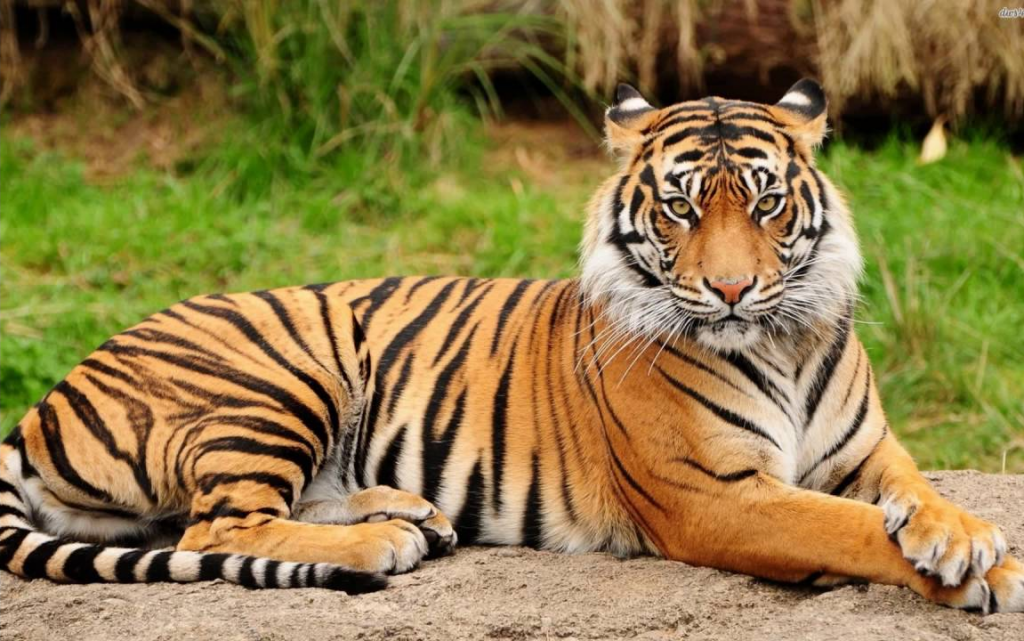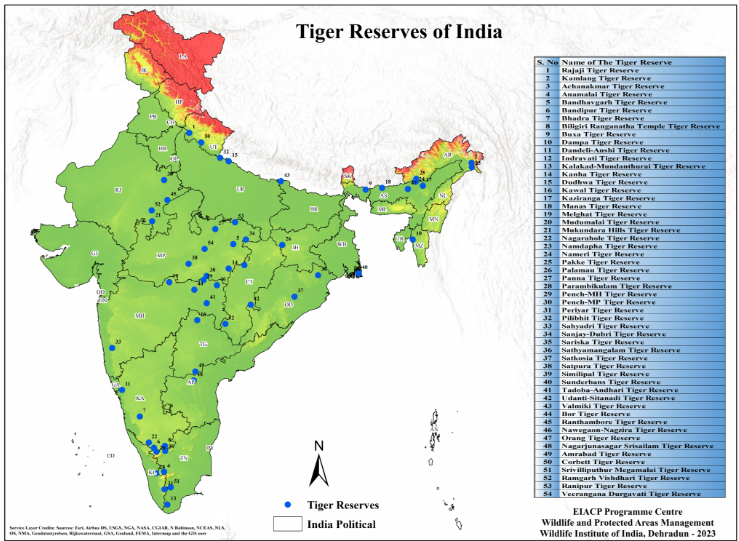Table of Contents
The magnificent Panthera tigris, also known as the tiger, is a striking striped animal. It has a thick, vibrant yellow coat of fur adorned with dark, contrasting stripes. The captivating combination of grace, strength, agility, and immense power has rightfully earned the tiger its revered status as the national animal of India.

Out of the eight recognized tiger subspecies, the Indian race, the Royal Bengal Tiger, is found throughout the country, except in the northwestern regions, and also in the neighboring countries of Nepal, Bhutan, and Bangladesh. The Bengal Tiger is a powerful predator and can weigh up to 570 pounds (260 kilograms) and grow up to 10 feet (3 meters) in length. It has distinctive orange fur with black stripes, and is known for its strength, agility, and hunting abilities.
To address the declining tiger population in India, a conservation initiative called ‘Project Tiger’ was launched in April 1973. Under this project, a total of 55 tiger reserves have been established across the country, covering an area of 78,735 square kilometers. India is home to 75% of the world’s tiger population. Recently, a report on the Status of Tigers in India was released, indicating a growth in the tiger population to 3167 from 2226, thus a 42% increase in the number of tigers, since 2014. These designated tiger reserves serve as sanctuaries to protect and nurture the iconic big cat, ensuring its continued presence in the Indian subcontinent.
Tiger Reserves in India
India is home to a diverse range of wildlife, including the Bengal tiger, one of the most majestic and endangered big cats in the world. To protect these iconic animals, the Indian government has established several tiger reserves across the country. When the project tiger was started in the year 1973 there were only 9 tiger reserves in the entire country. This number has jump to 55 as of August 2024. Dholpur-Karauli is the 55th tiger reserve in India Approved by National Tiger Conservation Authority on 22nd August 2023.

| S. No. | Name of Tiger Reserve | State | Year of Inclusion under Project Tiger |
| 1. | Nagarjunsagar Srisailam Tiger Reserve | Andhra Pradesh | 1982-1983 |
| 2. | Kamlang Tiger Reserve | Arunachal Pradesh | 2016-2017 |
| 3. | Namdapha Tiger Reserve | Arunachal Pradesh | 1982- 1983 |
| 4. | Pakke Tiger Reserve | Arunachal Pradesh | 1999-2000 |
| 5. | Kaziranga Tiger Reserve | Assam | 2008-2009 |
| 6. | Manas Tiger Reserve | Assam | 1973-1974 |
| 7. | Nameri Tiger Reserve | Assam | 1999-2000 |
| 8. | Orang Tiger Reserve | Assam | 2016 |
| 9. | Valmiki Tiger Reserve | Bihar | 1989-1990 |
| 10. | Achanakmar Tiger Reserve | Chhattisgarh | 2008-2009 |
| 11. | Indravati Tiger Reserve | Chhattisgarh | 1982-1983 |
| 12. | Udanti-Sitanadi Tiger Reserve | Chhattisgarh | 2008-2009 |
| 13. | Palamau Tiger Reserve | Jharkhand | 1973-1974 |
| 14. | Bandipur Tiger Reserve | Karnataka | 1973-1974 |
| 15. | Bhadra Tiger Reserve | Karnataka | 1994-1995 |
| 16. | Biligiri Ranganatha Temple Tiger Reserve | Karnataka | 2010-2011 |
| 17. | Dandeli-Anshi (Kali) Tiger Reserve | Karnataka | 2008-2009 |
| 18. | Nagarahole Tiger Reserve | Karnataka | 2008-2009 |
| 19. | Parambikulam Tiger Reserve | Kerala | 2008-2009 |
| 20. | Periyar Tiger Reserve | Kerala | 1978-1979 |
| 21. | Bandhavgarh Tiger Reserve | Madhya Pradesh | 1993-1994 |
| 22. | Kanha Tiger Reserve | Madhya Pradesh | 1973-1974 |
| 23. | Panna Tiger Reserve | Madhya Pradesh | 1993-1994 |
| 24. | Pench Tiger Reserve | Madhya Pradesh | 1992-1993 |
| 25. | Sanjay-Dubri Tiger Reserve | Madhya Pradesh | 2008-2009 |
| 26. | Satpura Tiger Reserve | Madhya Pradesh | 1999-2000 |
| 27. | Veerangana Durgavati Tiger Reserve | Madhya Pradesh | – |
| 28. | Bor Tiger Reserve | Maharashtra | 2014 |
| 29. | Melghat Tiger Reserve | Maharashtra | 1973-1974 |
| 30. | Nawegaon-Nagzira Tiger Reserve | Maharashtra | 2013-2014 |
| 31. | Pench Tiger Reserve | Maharashtra | 1998-1999 |
| 32. | Sahyadri Tiger Reserve | Maharashtra | 2009-2010 |
| 33. | Tadoba-Andhari Tiger Reserve | Maharashtra | 1993-1994 |
| 34. | Dampa Tiger Reserve | Mizoram | 1994-1995 |
| 35. | Satkosia Tiger Reserve | Odisha | 2008-2009 |
| 36. | Similipal Tiger Reserve | Odisha | 1973-1974 |
| 37. | Mukandra Hills Tiger Reserve | Rajasthan | 2013-2014 |
| 38. | Ramgarh Vishdhari Tiger Reserve | Rajasthan | 2022 |
| 39. | Ranthambore Tiger Reserve | Rajasthan | 1973-1974 |
| 40. | Sariska Tiger Reserve | Rajasthan | 1978-1979 |
| 41. | Anamalai Tiger Reserve | Tamil Nadu | 2008-2009 |
| 42. | Kalakad-Mundanthurai Tiger Reserve | Tamil Nadu | 1988-1989 |
| 43. | Mudumalai Tiger Reserve | Tamil Nadu | 2008-2009 |
| 44. | Sathyamangalam Tiger Reserve | Tamil Nadu | 2013-2014 |
| 45. | Srivilliputhur Megamalai Tiger Reserve | Tamil Nadu | 2020-2021 |
| 46. | Amrabad Tiger Reserve | Telangana | 2014-2015 |
| 47. | Kawal Tiger Reserve | Telangana | 2012-2013 |
| 48. | Dudhwa Tiger Reserve | Uttar Pradesh | 1987-1988 |
| 49. | Pilibhit Tiger Reserve | Uttar Pradesh | 2014 |
| 50. | Ranipur Tiger Reserve | Uttar Pradesh | 2022-2023 |
| 51. | Corbett Tiger Reserve | Uttarakhand | 1973-1974 |
| 52. | Rajaji Tiger Reserve | Uttarakhand | 2015 |
| 53. | Buxa Tiger Reserve | West Bengal | 1982-1983 |
| 54. | Sunderbans Tiger Reserve | West Bengal | 1973-1974 |
| 55. | Dholpur – Karauli Tiger Reserve | Rajasthan | 2023 |
Some Interesting Facts
- Bengal Tiger was declared as the national animal of India in April 1973.
- International Tiger Day is celebrated each year on July 29 to turn the spotlight on the conservation of tigers worldwide.
- Since 2010, Royal Bengal Tiger has been classified as an endangered animal by IUCN.
- Male Bengal tigers have an average length of 2.7m to 3.1m including the tail, while females measure 2.4m to 2.65m on average.




 How Many Candidates Applied for DFCCIL R...
How Many Candidates Applied for DFCCIL R...
 Delhi Sultanate, Notes on Dynasties of M...
Delhi Sultanate, Notes on Dynasties of M...
 Free Study Material for SSC CGL 2025, Do...
Free Study Material for SSC CGL 2025, Do...


